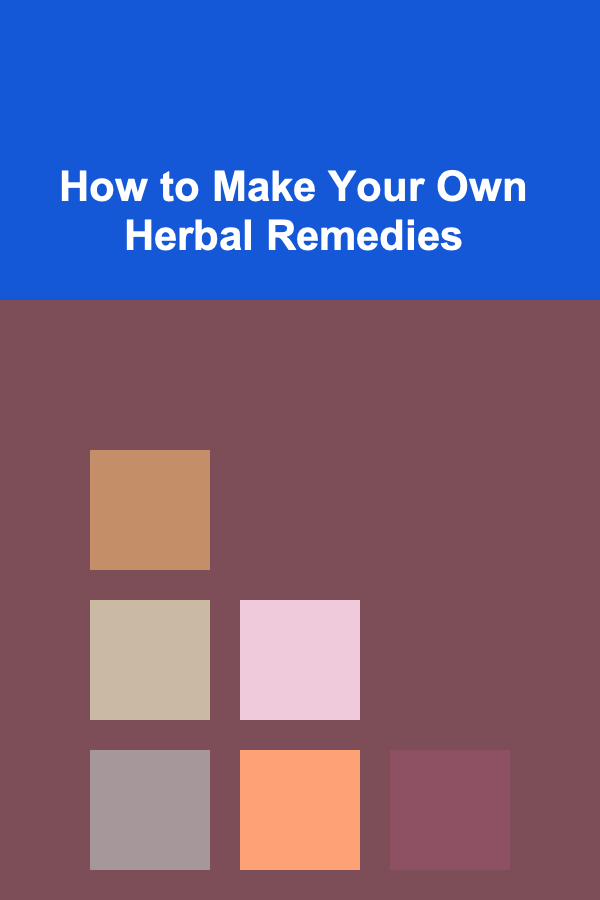
How to Make Your Own Herbal Remedies
ebook include PDF & Audio bundle (Micro Guide)
$12.99$5.99
Limited Time Offer! Order within the next:

Herbal remedies have been used for centuries in cultures around the world to treat ailments, improve health, and promote general wellness. The practice of using plants for medicinal purposes is known as herbalism. With the growing interest in natural healing and wellness, many people are turning to herbal remedies as alternatives to pharmaceutical treatments. Learning how to make your own herbal remedies can be a rewarding and empowering experience. Not only can it help you support your health, but it also connects you with nature in a meaningful way.
In this article, we will explore the basics of herbal remedies, the essential tools and materials needed, how to properly identify herbs, and how to create your own remedies at home. Whether you are interested in creating soothing teas, tinctures, salves, or infusions, this guide will provide you with the knowledge to make your own natural remedies.
The Basics of Herbal Remedies
Herbal remedies are made from plants and their various parts, including leaves, flowers, roots, bark, and seeds. These plants contain natural compounds that can have medicinal properties, such as alkaloids, flavonoids, tannins, and essential oils. The active ingredients in these compounds are what make herbal remedies effective for treating different conditions.
The Science Behind Herbal Remedies
Herbal medicine works on the principle of using whole plants or plant extracts to influence the body's natural healing processes. Unlike pharmaceuticals, which typically isolate a single active compound, herbal remedies use the synergy of various plant compounds. This holistic approach is often believed to be gentler and less likely to produce side effects than synthetic drugs.
Herbal remedies can be used for a wide variety of health concerns, such as:
- Digestive issues (e.g., nausea, indigestion, bloating)
- Stress and anxiety (e.g., calming herbs like chamomile and lavender)
- Skin care (e.g., soothing aloe vera for burns and rashes)
- Immune support (e.g., echinacea and elderberry)
- Pain relief (e.g., willow bark and turmeric)
Understanding Herbal Preparations
Herbal remedies come in many forms, depending on the type of plant and the desired effect. Some common preparations include:
Infusions
An infusion is a method of extracting the medicinal properties of an herb by steeping it in hot water. This is most commonly used for herbs with delicate leaves or flowers, such as chamomile or peppermint. To make an infusion:
- Boil water and pour it over the herbs.
- Let it steep for 10-15 minutes, then strain the herbs out.
- Drink the infusion warm or chilled.
Decoctions
A decoction is similar to an infusion but is used for tougher plant materials such as roots, bark, or seeds. These parts contain denser compounds, which require longer cooking times to release their medicinal properties. To make a decoction:
- Place the herb in a pot of cold water.
- Bring the water to a boil and then reduce the heat to simmer.
- Allow the herbs to simmer for 20-30 minutes, then strain.
Tinctures
A tincture is a concentrated liquid extract made by soaking herbs in alcohol (or sometimes vinegar) for an extended period of time, typically 2-6 weeks. The alcohol extracts the active compounds in the herb. To make a tincture:
- Fill a glass jar halfway with dried herbs.
- Cover the herbs completely with alcohol (vodka or brandy works well).
- Seal the jar and store it in a cool, dark place for 2-6 weeks, shaking it gently every few days.
- Strain the herbs and store the tincture in a dark glass bottle.
Salves and Ointments
A salve is a thick, oily preparation used for topical applications. It is typically made by combining herbal-infused oils with beeswax or another thickening agent to create a balm-like consistency. To make a salve:
- Infuse an herb (like calendula or lavender) in olive oil by heating it gently for a few hours.
- Strain the herb from the oil and add beeswax to the oil to thicken it.
- Heat the mixture until the beeswax is melted, then pour it into small containers to solidify.
Oils and Extracts
Herbal oils are made by infusing an herb in a carrier oil like olive oil or coconut oil. The process is similar to making a tincture but without alcohol. This method is often used for topical applications to moisturize and heal the skin. To make herbal oils:
- Fill a jar with dried herbs and cover them with a carrier oil.
- Let the jar sit in a warm, sunny spot for 2-4 weeks, shaking it occasionally.
- Strain the oil and store it in a dark bottle.
Essential Tools and Materials for Making Herbal Remedies
Making herbal remedies requires some basic tools, but the investment is minimal compared to the cost of buying pre-made products. Here's a list of essentials:
1. Herbs
To make your own herbal remedies, you will need a variety of herbs. You can grow them in your garden, forage for wild plants (if you are knowledgeable about plant identification), or purchase them from a reputable source. It's important to buy herbs that are organic and free from pesticides and chemicals.
2. Mortar and Pestle
A mortar and pestle is essential for grinding herbs, crushing dried plant matter, and releasing their natural oils and compounds. This tool is particularly useful for making tinctures and salves.
3. Jars and Containers
Glass jars are ideal for storing your herbal remedies. You will need jars for infusions, tinctures, oils, and salves. Choose dark-colored glass to protect the herbs from sunlight, which can degrade their potency.
4. Strainers and Cheesecloth
When making infusions, decoctions, or oils, you will need a strainer or cheesecloth to separate the liquid from the plant material.
5. Double Boiler or Slow Cooker
For creating oils and salves, a double boiler or slow cooker will allow you to gently heat herbs without burning them. This is especially important when infusing herbs in oil or melting beeswax for salves.
6. Beeswax (for Salves)
Beeswax is commonly used to thicken herbal oils into salves or balms. It also acts as a natural preservative.
7. Alcohol (for Tinctures)
A high-proof alcohol like vodka or brandy is commonly used to create tinctures. The alcohol helps to extract the active compounds from the herbs.
8. Labels and Markers
Once you've made your herbal remedies, it's a good idea to label them with the name of the herb, the preparation method, and the date they were made. This will help you keep track of your remedies and their shelf life.
Identifying and Harvesting Herbs
Before making your own herbal remedies, you need to know how to properly identify and harvest herbs. This is a crucial step, as some plants may look similar to others but have vastly different properties. Here are some tips for identifying and harvesting herbs:
1. Learn Plant Identification
Study a reliable field guide or take a local herb identification class. Make sure you are confident in your plant identification skills before harvesting any wild herbs.
2. Harvest at the Right Time
Most herbs are best harvested during their peak growth period when they are full of essential oils and active compounds. Typically, this is when the plant is in bloom or just before it starts to flower.
3. Harvesting Responsibly
When foraging for wild plants, make sure to harvest sustainably. Avoid taking too much from any one plant or location, and ensure that the plant is abundant in the wild. Never take plants that are endangered or protected by law.
Safety Considerations
While herbal remedies are generally safe, it's important to approach them with caution. Always research herbs thoroughly before using them, and be aware of any potential interactions with medications or underlying health conditions.
1. Consult a Healthcare Provider
If you are taking prescription medications or have any medical conditions, it's important to consult a healthcare provider before using herbal remedies. Some herbs may interact with medications or cause allergic reactions.
2. Start Slowly
When trying a new herbal remedy, start with a small dose to see how your body reacts. Some herbs may cause mild side effects such as digestive upset or skin irritation.
3. Pregnancy and Breastfeeding
If you are pregnant or breastfeeding, be extra cautious when using herbal remedies, as some herbs may not be safe during pregnancy.
The Benefits of Making Your Own Herbal Remedies
Making your own herbal remedies offers numerous benefits:
1. Cost Savings
Buying pre-made herbal remedies can be expensive, but making them yourself allows you to save money while still reaping the health benefits.
2. Personalized Care
When you make your own remedies, you can tailor them to your specific needs. You can select herbs that work best for your individual health concerns, ensuring a more personalized approach to wellness.
3. Connection with Nature
Creating your own remedies fosters a deeper connection with nature and the plants that support your well-being. Growing your own herbs or foraging for them allows you to connect with the earth and its healing properties.
4. Empowerment and Knowledge
By learning how to make your own herbal remedies, you gain knowledge and skills that empower you to take control of your health. You will feel more confident in your ability to care for yourself and your loved ones.
Conclusion
Making your own herbal remedies is a rewarding and fulfilling practice that connects you with nature and provides a holistic approach to health and wellness. By understanding the basics of herbal medicine, learning how to properly identify and harvest herbs, and mastering various herbal preparations, you can create effective remedies that support your well-being. Whether you're making teas, tinctures, or salves, the process of creating your own herbal remedies empowers you to take control of your health in a natural, sustainable way.
Reading More From Our Other Websites
- [Home Pet Care 101] How to Safely Remove a Tick from Your Pet
- [Personal Investment 101] How to Maximize Your Roth IRA: A Comprehensive Guide for Long-Term Growth
- [Soap Making Tip 101] Best Low‑pH Soap Recipes for Acne‑Prone Skin
- [Home Soundproofing 101] How to Soundproof Your Bathroom for More Privacy
- [Beachcombing Tip 101] From Fossil to Fancy: The Story Behind the Rarest Shell Specimens
- [Home Storage Solution 101] How to Organize Your Craft Room for Maximum Functionality
- [Organization Tip 101] How to Organize Baking Supplies for Quick Access
- [Organization Tip 101] How to Speed Up Your Wallpaper Removal Project with a Steamer
- [Soap Making Tip 101] Scent-sational Creations: Beginner‑Friendly Soap Recipes to Try Today
- [Home Rental Property 101] How to Create a Lease Agreement That Protects Both Parties

How to Build a Checklist for Staying Updated with Social Media Trends
Read More
How to Layer Lighting for a Balanced Look in Your Living Room
Read More
How to Stage a Home with a Small Budget and Limited Time
Read More
How To Understand Craft Beer Ingredient Sourcing
Read More
How To Study Marine Ecosystem Services
Read More
How to Address Christmas Cards with Children: A Fun Family Activity
Read MoreOther Products

How to Build a Checklist for Staying Updated with Social Media Trends
Read More
How to Layer Lighting for a Balanced Look in Your Living Room
Read More
How to Stage a Home with a Small Budget and Limited Time
Read More
How To Understand Craft Beer Ingredient Sourcing
Read More
How To Study Marine Ecosystem Services
Read More